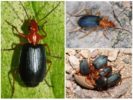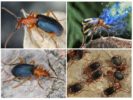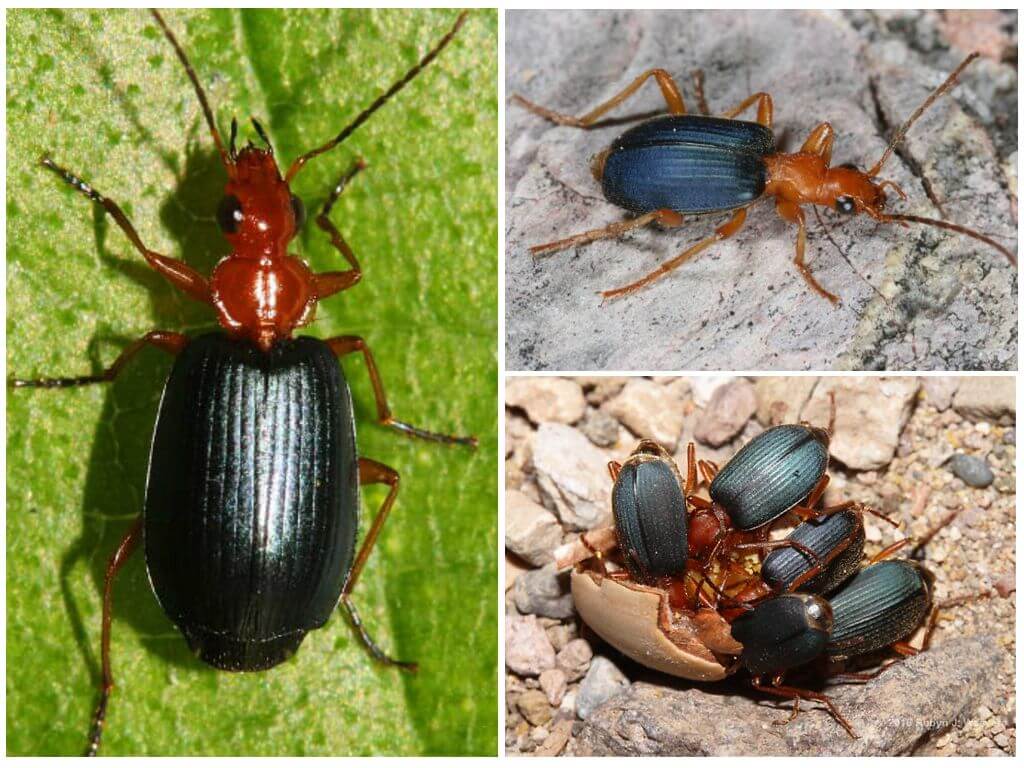- Bombardier beetle
- Beetle lifestyle
Every living creature, whether it is a small insect or a giant animal, is endowed not only with a peculiar appearance, but also with the ability to protect itself at the moment of danger. A striking example of this fact is the bombardier beetle. About the features of lifestyle, body structure and the protective mechanism of the beetle, this article will tell.
What does an insect look like?
The bombardier beetle is a representative of the subfamilies Paussinae (less studied group) or Brachininae (the most studied and largest group), which belong to ground beetles. Insects live almost everywhere, with the exception of the Antarctic regions.
The bombardier beetle has no attractive appearance:
- oblong body reaches a length of up to 3 cm and has a red color;
- insect wings are protected by a dense carapace, elytra, painted in brown, dark blue or dark green, are located on top;
- the back of some scorers is decorated with a contrasting pattern of rounded spots.
Most representatives of this family do not know how to fly, but they move very quickly due to three pairs of symmetrically arranged legs. Extremities and chest of the insect in red tones. The head is also bright and has segmented whiskers up to 8 mm long. The color of this type is evidence of the predatory nature of individuals of this species (the beetle scorer photo is presented below).
Lifestyle
The bombardier beetle is active at night, during the day he tries to take refuge in a shelter: under stones, logs, various snags. He is forced to lead such a lifestyle in order not to become a victim of birds. Representatives of Brachininae and Paussinae live in groups. Food for them are insect larvae, earthworms, and they do not disdain carrion.
Interesting!
In order to take off, the bug needs a certain time to release its wings, which significantly increases the risk of becoming an enemy victim. In such situations, the insect's self-preservation instinct triggers: its own chemical weapons come to the rescue.
Protection mechanism
The ability to defend itself is the main feature of the insect. At the moment of danger, the bombardier beetle sprays a stream of a mixture of toxic components into the enemy. Burning liquid is released more than once. The number of subsequent emissions in turn can be from 4 to 9 pieces, and their speed is up to 10 m / s. Beetles that have not used their defense mechanism before are capable of making about three dozen shots in a row.
The protective system of the beetle is located on the last segments of the abdomen. A pair of symmetrically arranged endocrine glands secrete a burning mixture, which includes hydroquinone and hydrogen peroxide. These chemical elements are stored in a large reservoir, which is located in the abdominal cavity of the insect.
At the time of threat, the beetle contracts its muscles. This helps push the contents of the tank into a special chamber. Its walls are lined with cells capable of producing oxidative enzymes (catalase and peroxidase). The reaction of all these components contributes to the formation of free oxygen and heat. As a result, at the moment of release of the burning fluid, you can hear cotton and even observe haze.
An amazing feature of the “weapon” is its ability to extend and bend in the necessary direction, which makes it possible to attack the enemy in different directions.So directing the "gun" towards the enemy, the scorer releases a portion of the caustic mixture, the temperature of which is close to 100 degrees.
This method allows the scorer to protect himself from ants, spiders, praying mantises, and even from his relatives, for whom he serves as a favorite treat. Almost instant death awaits the fired enemy. Beetles, frogs and lizards will not refuse to eat ground beetles. However, having received quite noticeable burns, they no longer dare to attack the enemy again.
Important!
If you take the scorer with your bare hands, then there is a high probability of getting a very painful skin burn. Not the best option to view this bug at close range. A jet entering the eye can even cause vision loss.
Breeding
After mating, the female begins to roll small balls from the ground into which she lays eggs (one soil lump is designed for one egg). Such semblance of spheres will serve as a refuge for the development of larvae.
Of interest is the process of pupation of the larvae that have been born. Since ground beetles are predators, their larvae lead a parasitic lifestyle. For nutrition and growth, young offspring use pupae of other insects, eating their insides. In most cases, the bear suffers from this. The empty chitin cocoon, the bombardier larvae are used as new housing, where as a result of metamorphosis they turn into a chrysalis and then into an adult. The life of a scorer is no more than two weeks.







